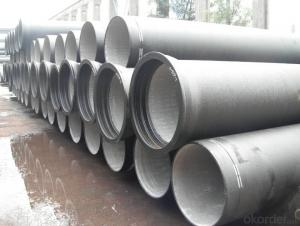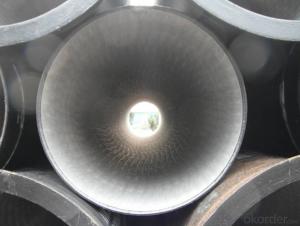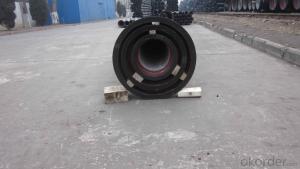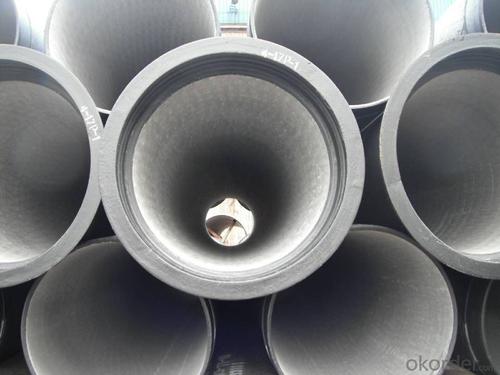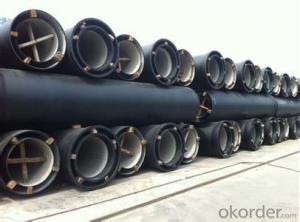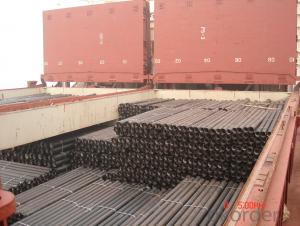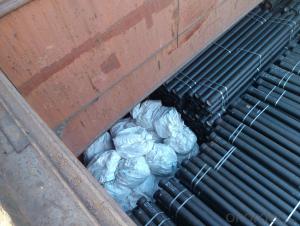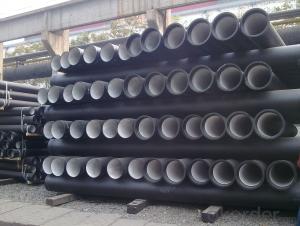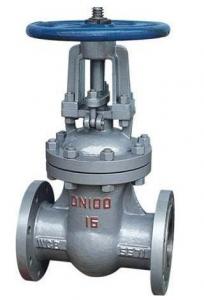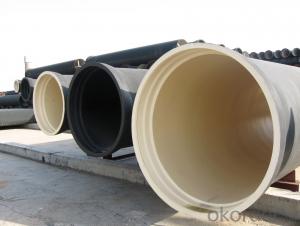DUCTILE IRON PIPE DN1200 K9/C
- Loading Port:
- China Main Port
- Payment Terms:
- TT OR LC
- Min Order Qty:
- -
- Supply Capability:
- -
OKorder Service Pledge
OKorder Financial Service
You Might Also Like
Specification:
1) The standard of pipe: ISO2531:1998, K9
2) Effective length: 6m
3) Inner cement line: Portland cement line as per ISO4179
4) Zinc coating: at least 130g/m2 as per ISO8179
5) Bitumen painting: at least 70um as per ISO8179
6) With 100% quantity of NBR ring, or SBR ring, or EPDM ring as per ISO4633
7) DN80mm-800mm
8) High strength, lighter than grey iron, good corrosion resistance, no furring, small flow resistance, easy fixing, long life tome about 100 yeas
9) Produced by Hangzhou chunfeng machine
10) Checked by automatic inspection equipment
11) Composition:
Chemical composition | |||
Chemical composition | Ductile Cast Iron Pipe (%) | Grey iron pipe (%) | Steel pipe (%) |
C | 3.5-4.0 | 3.2-3.8 | 0.1-0.2 |
Si | 1.9-2.6 | 1.4-2.2 | 0.15-0.4 |
Mn | 0.15-0.45 | 0.4-0.6 | 0.3-0.6 |
P | ≤0.06 | ≤0.3 | 0.02-0.03 |
S | ≤0.02 | ≤0.1 | 0.02-0.03 |
Mg | 0.03-0.06 |
|
|
12) Feature:
Mechanical properties | |||
| Ductile Cast Iron Pipe | Grey Iron Pipe | Steel Pipe |
Tensile Strength(Mpa) | ≥420 | 150-260 | ≥400 |
Yield Strength(Mpa) | ≥300 | No Confirmation | No Confirmation |
Bending Strength(Mpa) | ≥590 | 200-360 | ≥400 |
Elongation (%) | ≥10 | Neglected | ≥18 |
Brinell Hardness(HBS) | ≤230 | ≤230 | About 140 |
13) T type mechanical joint
14) Packing: in bulk or container
- Q: What is the cost of ductile iron pipes compared to other materials?
- The cost of ductile iron pipes compared to other materials can vary depending on several factors such as the size, length, and application of the pipes. In general, ductile iron pipes tend to be more expensive than other materials such as PVC or HDPE (high-density polyethylene) pipes. This is primarily due to the superior strength, durability, and longevity offered by ductile iron pipes. While the initial cost of ductile iron pipes may be higher, they often provide a more cost-effective solution in the long run due to their extended lifespan. Ductile iron pipes have a life expectancy of over 100 years, making them a highly reliable and low-maintenance choice for water, sewage, and gas distribution systems. This longevity reduces the need for frequent replacements, repairs, and associated costs. Furthermore, ductile iron pipes are known for their exceptional resistance to external loads, pressure, and corrosion. This makes them well-suited for a wide range of applications, including high-pressure water and gas transmission, industrial pipelines, and sewer systems. The inherent strength of ductile iron pipes allows for thinner walls, resulting in reduced material and installation costs when compared to other materials. It is important to note that the cost of ductile iron pipes can also be influenced by market conditions, transportation costs, and availability of raw materials. Therefore, it is always advisable to consult with suppliers and conduct a cost-benefit analysis before making a decision.
- Q: Are ductile iron pipes suitable for pressure reducing valve stations?
- Yes, ductile iron pipes are suitable for pressure reducing valve stations. Ductile iron pipes are known for their strength and durability, which makes them an ideal choice for applications involving high pressure. Pressure reducing valve stations are designed to regulate and reduce the pressure of a fluid or gas in a pipeline system. Ductile iron pipes can handle the pressure exerted by the fluid or gas, ensuring a reliable and efficient operation of the pressure reducing valve station. Additionally, ductile iron pipes have excellent resistance to corrosion, which is crucial in maintaining the integrity of the pipeline system and preventing leaks or failures. Overall, ductile iron pipes provide the necessary strength, durability, and corrosion resistance required for pressure reducing valve stations.
- Q: Can ductile iron pipes be used for both water and sewage systems?
- Yes, ductile iron pipes can be used for both water and sewage systems. Ductile iron pipes are known for their strength and durability, making them suitable for various applications. They have excellent resistance to corrosion and can withstand high pressures, making them ideal for transporting both water and sewage.
- Q: How are ductile iron pipes transported and stored?
- Ductile iron pipes are typically transported and stored in a systematic and careful manner to ensure their safety and integrity. Transportation of ductile iron pipes usually involves the use of specialized vehicles, such as flatbed trucks or trailers, that are capable of accommodating the size and weight of the pipes. These vehicles are equipped with appropriate securing mechanisms to prevent any movement or damage during transit. The pipes are loaded onto the vehicles using forklifts or cranes, ensuring that they are properly supported and balanced to avoid any bending or deformation. During transportation, it is crucial to protect the pipes from external factors that could potentially cause damage. This includes placing covers or wraps over the pipes to shield them from adverse weather conditions, such as rain, snow, or excessive sunlight. Additionally, securing the pipes with straps or chains can prevent any shifting or rolling during transit. When it comes to storage, ductile iron pipes are typically stacked on specially designed racks or supports in a horizontal position. This allows for even weight distribution and minimizes the risk of deformation or stress on the pipes. The storage area should be clean, dry, and well-ventilated to prevent corrosion or deterioration. It is important to handle ductile iron pipes with care to avoid any impact or rough handling that could result in cracks or fractures. Workers involved in the transportation and storage process should be adequately trained to ensure they follow proper protocols and use the necessary equipment, such as lifting machinery and protective gear. Regular inspection of transported and stored ductile iron pipes is essential to identify any signs of damage or corrosion. This allows for timely repairs or replacements, preventing any potential issues when the pipes are installed for their intended use. Overall, the transportation and storage of ductile iron pipes require careful planning, proper equipment, and adherence to safety protocols to ensure their condition and performance are maintained.
- Q: What does ductile iron pipe "K" mean?
- 1 、 pipe fittings are K type, T type, etc.;2 wall thickness registration symbol. For example, according to the pipe quality standards GB/T13295-K9, which is the wall thickness ofK=9* (DN/1000+0.5)
- Q: Are there any alternatives to ductile iron pipe for water distribution?
- There are various options available for water distribution besides ductile iron pipe. Some commonly used alternatives include: 1. PVC (Polyvinyl Chloride) Pipe: PVC pipe is frequently chosen for water distribution due to its affordability, durability, and resistance to corrosion. It is lightweight, easy to install, and requires minimal maintenance. 2. HDPE (High-Density Polyethylene) Pipe: HDPE pipe is a flexible and durable choice for water distribution. It is resistant to corrosion, chemicals, and UV rays, making it suitable for both aboveground and underground installations. HDPE pipe is also known for its leak-free joints and long lifespan. 3. PEX (Cross-linked Polyethylene) Pipe: PEX pipe, a flexible plastic pipe, is commonly utilized for water distribution in residential and commercial settings. It is recognized for its ability to withstand freezing, scaling, and corrosion. PEX pipe is easy to install, has fewer joints, and is highly durable. 4. Copper Pipe: Copper pipe has a long history of use in water distribution due to its exceptional resistance to corrosion and extended lifespan. Although it is more expensive than other alternatives, copper pipe is renowned for its reliability and ability to handle high pressure. 5. Steel Pipe: Steel pipe is a robust and durable option for water distribution, particularly in high-pressure scenarios. It can endure extreme temperatures and resist external loads. However, steel pipe is more costly and requires specialized installation techniques. When selecting an alternative to ductile iron pipe for water distribution, it is crucial to consider factors such as cost, durability, corrosion resistance, installation requirements, and specific project needs.
- Q: Can ductile iron pipes be used for underground wastewater outfalls?
- Yes, ductile iron pipes can be used for underground wastewater outfalls. Ductile iron pipes are a popular choice for underground applications due to their durability, strength, and corrosion resistance. They are designed to withstand high pressure and external loading, making them suitable for transporting wastewater over long distances and depths. Additionally, ductile iron pipes have a smooth internal surface, which helps to minimize friction and prevent the buildup of sediments or debris that could potentially block the flow of wastewater. Therefore, ductile iron pipes are commonly used in underground wastewater systems, including outfalls, to ensure efficient and reliable wastewater transport while minimizing the risk of pipe failure or blockages.
- Q: What are the advantages of using ductile iron pipe?
- Using ductile iron pipe in various applications offers several benefits. Firstly, ductile iron pipe is renowned for its strength and durability. It possesses higher tensile and yield strengths compared to other pipe materials, making it highly resistant to cracking, bending, and breaking. This exceptional strength enables the pipe to withstand high-pressure and heavy-load conditions, making it an ideal choice for applications such as water and sewage systems, oil and gas pipelines, and industrial piping. Secondly, ductile iron pipe exhibits excellent corrosion resistance. It is coated with a protective layer, typically zinc or epoxy, which prevents rusting and corrosion. This coating ensures a longer lifespan for the pipe, even in harsh environments or when transporting corrosive fluids. Another advantage of ductile iron pipe lies in its flexibility. Unlike rigid pipes, ductile iron pipes possess a certain level of flexibility, enabling them to endure ground movements and settle without fracturing. This flexibility proves particularly advantageous in areas prone to earthquakes or soil settlements. Additionally, ductile iron pipe boasts a smooth inner surface, minimizing flow resistance and enhancing fluid transportation efficiency. It also reduces the likelihood of sediment accumulation or corrosion within the pipe, resulting in improved flow rates and decreased maintenance requirements. Furthermore, ductile iron pipe proves cost-effective in the long run. Although it may entail higher initial costs compared to other pipe materials, its durability and minimal maintenance needs make it a cost-effective choice over time. The extended lifespan of ductile iron pipe reduces the necessity for frequent replacements and repairs, contributing to lower overall life-cycle expenses. Lastly, ductile iron pipe exhibits environmental friendliness. It is manufactured using recycled materials, and its extended lifespan diminishes the need for frequent replacements, thereby reducing the carbon footprint associated with manufacturing and transportation. In conclusion, the utilization of ductile iron pipe offers numerous advantages, including exceptional strength, corrosion resistance, flexibility, smooth inner surface, cost-effectiveness, and environmental friendliness. These qualities establish it as a reliable and preferred option for various applications across diverse industries.
- Q: What is the average cost of ductile iron pipe?
- The average cost of ductile iron pipe can vary depending on several factors such as the diameter, length, and thickness of the pipe, as well as the supplier and location. On average, however, ductile iron pipe can range from approximately $40 to $200 per linear foot. It is important to note that these prices are estimates and can fluctuate based on market conditions and other variables. It is recommended to contact local suppliers or distributors for specific pricing information tailored to your project requirements.
- Q: Are ductile iron pipes suitable for industrial applications?
- Yes, ductile iron pipes are suitable for industrial applications. Due to their excellent strength, durability, and resistance to corrosion, ductile iron pipes are commonly used in industrial settings such as water and wastewater treatment plants, power plants, and chemical processing plants. They can handle high-pressure systems, have a long service life, and are cost-effective, making them a reliable choice for various industrial applications.
Send your message to us
DUCTILE IRON PIPE DN1200 K9/C
- Loading Port:
- China Main Port
- Payment Terms:
- TT OR LC
- Min Order Qty:
- -
- Supply Capability:
- -
OKorder Service Pledge
OKorder Financial Service
Similar products
Hot products
Hot Searches
Related keywords

